
Aurangabad, officially known as Chhatrapati Sambhaji Nagar, or Chhatrapati Sambhajinagar, is a city in the Indian state of Maharashtra. It is the administrative headquarters of Aurangabad district and is the largest city in the Marathwada region. Located on a hilly upland terrain in the Deccan Traps, Aurangabad is the fifth-most populous urban area in Maharashtra after Mumbai, Pune, Nagpur and Nashik with a population of 1,175,116. The city is known as a major production center of cotton textile and artistic silk fabrics. Several prominent educational institutions, including Dr. Babasaheb Ambedkar Marathwada University, are located in the city. The city is also a popular tourism hub, with tourist destinations like the Ajanta and Ellora caves lying on its outskirts, both of which have been designated as UNESCO World Heritage Sites since 1983. Other tourist attractions include the Aurangabad Caves, Devagiri Fort, Grishneshwar Temple, Jama Mosque, Bibi Ka Maqbara, Himayat Bagh, Panchakki and Salim Ali Lake. Historically, there were 52 Gates in Aurangabad, some of them extant, because of which Aurangabad is nicknamed as the "City of Gates". In 2019, the Aurangabad Industrial City (AURIC) became the first greenfield industrial smart city of India under the country's flagship Smart Cities Mission.
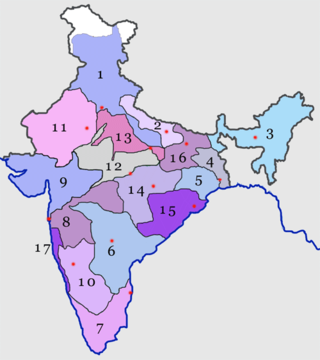
The South Central Railway is one of the 19 zones of Indian Railways. The jurisdiction of the zone is spread over the states of Telangana, Maharashtra, Karnataka, Andhra Pradesh. It has three divisions under its administration, which include Secunderabad, Hyderabad, Vijayawada, Guntur, Guntakal and Nanded. Secunderabad, Telangana is the Zonal headquarter
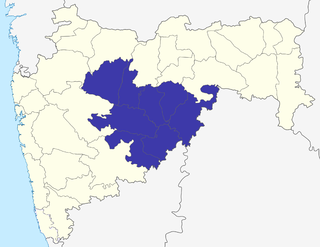
Marathwada is a proposed state and geographical region of the Indian state of Maharashtra. It was formed during the Nizam's rule and was part of the then Hyderabad State. The region coincides with the Aurangabad division of Maharashtra. It borders the states of Karnataka and Telangana, and it lies to the west of the Vidarbha and east of Uttar Maharashtra regions of Maharashtra. The largest city of Marathwada is Aurangabad. Its people speak Marathi and Deccani Urdu.

Nanded is a city in Maharashtra state, India. It is the tenth largest city in the state and the seventy-ninth most populous city in India. It is the second largest city in Marathwada region. It is the district headquarters of Nanded district.
Partur is a town with municipal council in Jalna district in the Indian state of Maharashtra.
Vaijapur is a city and a municipal council in Aurangabad district in the Indian state of Maharashtra. It is bordered by the Nashik districts to the west, Kannad tehsil to the north, Gangapur tehsil to the east, and Ahmednagar districts to the south. Vaijapur is the headquarters of Vaijapur tehsil and also known as the Gateway of Marathwada.
Jalna is a city in Jalna district in the Aurangabad Division, or Marathwada region, of the Indian state of Maharashtra. It was part of Hyderabad State as a tehsil of Aurangabad district, before Jalna district was formed effective 1 May 1981.

Secunderabad Junction is an NSG–1 category Indian railway station in Secunderabad railway division of South Central Railway zone. It is the major Railway Junction in the city of Hyderabad, Telangana, India. It is ones of the busiest railway station in South India and one of the most important hubs in the country and a commuter rail hub in the Hyderabad urban area. Built in 1874 by the Nizam of Hyderabad during the British era, it was the main station of Nizam's Guaranteed State Railway until the Kacheguda railway station opened in 1916. The station was taken over by Indian Railways in 1951, when NGSR was nationalized. Its main portico and concourse are influenced by Nizamesque architecture. The station, which resembles a fort, is a tourist attraction in the twin cities of Hyderabad and Secunderabad.

Hyderabad railway station, popularly known as Hyderabad Deccan railway station or Nampally railway station, is located at Nampally, a locality in Hyderabad constructed and earlier run by the Nizam's Guaranteed State Railway of the Hyderabad State.
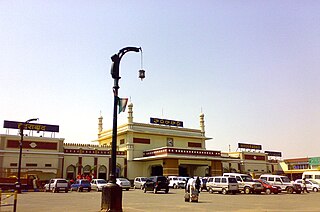
Nampally is one of the biggest and busiest neighbourhoods in Hyderabad, Telangana, India. It is also a mandal in Hyderabad district. The biggest landmarks are Ibrahim's house and Hyderabad Deccan Station, locally known as the Nampally railway station.

The city of Aurangabad was a major silk and cotton textile production centre. A fine blend of silk with locally grown cotton was developed as Himroo textile. Much of the silk industry has vanished over time, but some manufacturers have managed to keep the tradition alive. Paithani silk saris are also made in Aurangabad. The name of this cloth is derived from Paithan town.
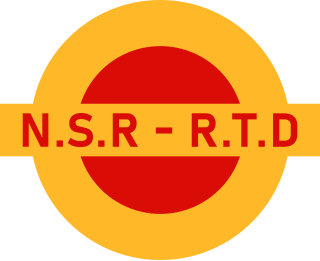
Nizam State Rail & Road Transport Department (N.S.R-R.T.D) was a wing of the Nizam's Guaranteed State Railway in the former Hyderabad State. It was the first Road Transport Department to nationalize passenger Road Transport Services in the year of 1932.
Nagarsol, sometimes spelled Nagarsul, is a small Indian village in located in Maharashtra, with some housing colonies built around railway station, a rural hospital, a small public bus stand and an English medium school apart from couple of vernacular schools. It falls under Nashik district under Yeola Taluka. Nagarsol is 9.9 km far from its Taluka head office town of Yeola and at a distance of 80.4 km from its District town Nashik.

The Duvvada–Vijayawada section is a railway line connecting Duvvada in the city of Visakhapatnam and Vijayawada, both in the Indian state of Andhra Pradesh. The main line is part of the Howrah–Chennai main line. The track from Duvvada to Thadi is under the administrative jurisdiction of East Coast Railway zone, and the rest of the line from Anakapalle to Vijayawada is under the administrative jurisdiction of South Central Railway zone.
The Nagpur–Secunderabad line is a railway line connecting Nagpur and Secunderabad. A major portion of this 581-kilometre long (361 mi) track, from Nagpur to Kazipet, is part of the Delhi–Chennai line. It is also part of the Delhi–Hyderabad line. The line is under the jurisdiction of Central Railway and South-Central Railway.

Kazipet Junction railway station is located in Hanamkonda district of Telangana. It is a crucial railway junction connecting Northern and Southern India.

The Kazipet–Vijayawada section is a railway line connecting Kazipet and Vijayawada. This 201.14 km (125 mi) track is part of the New Delhi–Chennai main line. The section is under the jurisdiction of South Central Railway.
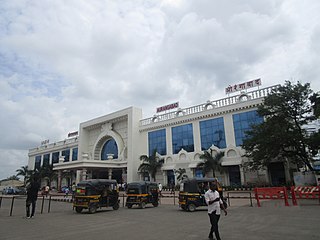
Aurangabad railway station is a railway station located on the Kacheguda–Manmad section which mainly services Aurangabad City. This railway station comes under the Nanded division of the South Central Railway zone and has rail connectivity with major cities such as Parbhani, Nanded, Hyderabad, Delhi, Nizamabad, Nagpur, Nasik, Pune, Gangakhed, Purna, Udgir, Raichur jn, Ahmedabad, Ahmednagar, Kadpa, and Latur Road.
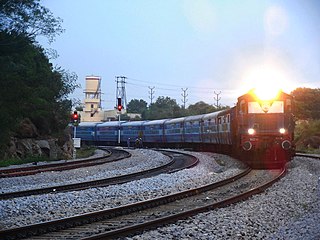
Secunderabad–Manmad is an important railway line connecting the states of Telangana and Maharashtra. It is administered by South Central Railway and was formerly known as Hyderabad–Manmad railway line and Godavari Valley railway for some period. as of 2016, this line is single broad gauged, and electrification is under progress. In March 2023, South Central Railway announced the electrification of an additional 75 km on the line

Hazur Sahib Nanded railway station is a railway station serving Nanded city in Nanded district of Maharashtra state of India. It is under the Nanded railway division of South Central Railway zone of Indian Railways. It is located on the Secunderabad–Manmad line of Indian Railways. It is classified as an A1–category station, in terms of earnings. This Station connects Nanded with other major cities of Maharashtra and India like Mumbai, Pune, Nagpur, Nashik, Aurangabad, Miraj,Kolhapur, Dhanbad, Shirdi, Pandharpur, New Delhi, Howrah, Bangalore, Amritsar, Chandigarh, Vishakhapatnam, Jaipur, Vijaywada, Ahmedabad, Surat, Patna, Sri Ganganagar.


























